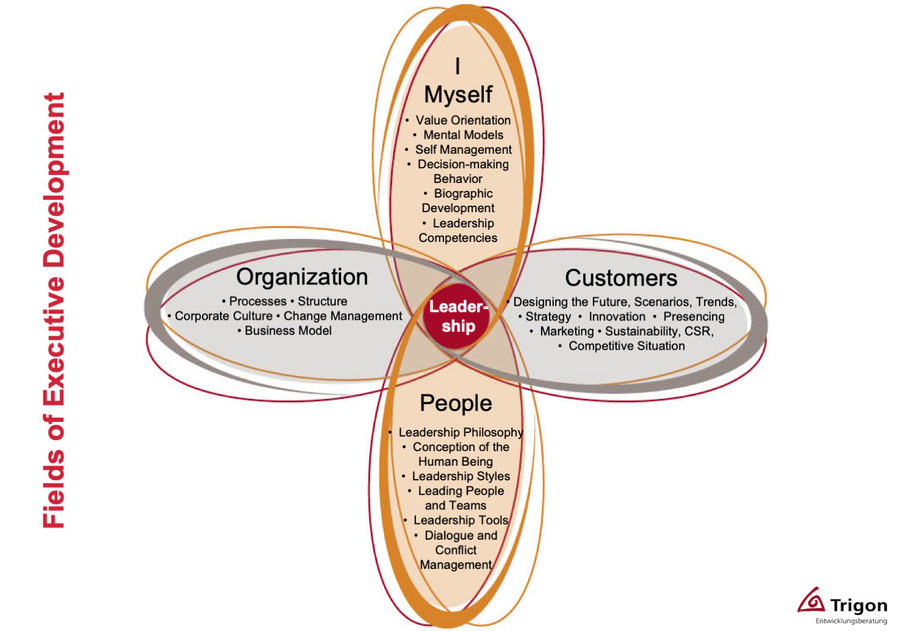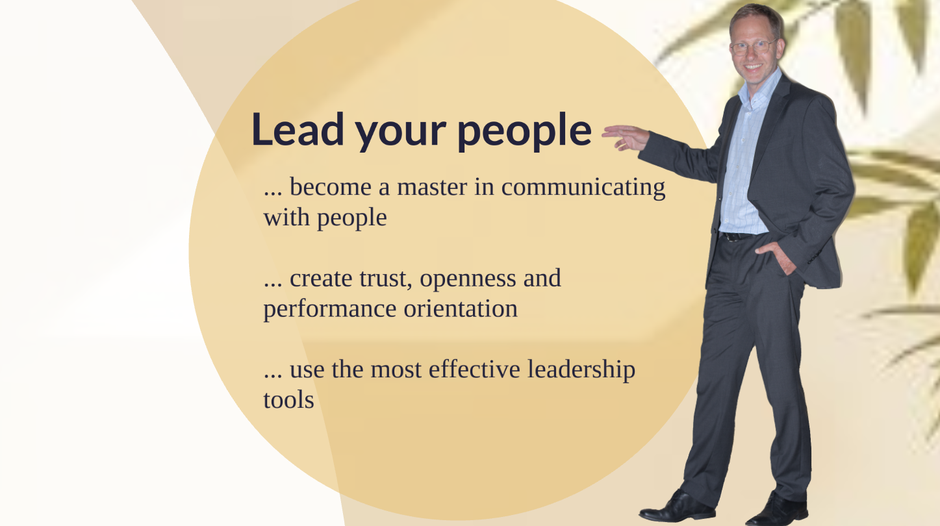
How can executive development programmes be designed to help companies deal with the challenges of the tasks they face today while at the same time preparing them for the future? What role do leadership and management skills play?
Harvard professor John P. Kotter is considered by many to have been the first to coin the term leadership in the way we understand it today. In his book “A Force for Change: How Leadership Differs from Management” (1990) he explains the difference between management and leadership. According to Kotter, managers tend to stand for the perfect organisation of processes, for planning and control. Leadership, on the other hand, means using visions to inspire and motivate others. It creates creativity, innovation, self-fulfilment and transformation.
Often, executives (especially in lower and middle management) find themselves in a dilemma. On the one hand, they are supposed to ensure that their employees take responsibility for their own actions. They are supposed to include them in decision-making processes and not simply set goals but agree on them. They are supposed to not only be open and transparent leaders, but also participative. Whatever you do, don’t be too authoritarian, is today’s leadership motto.
On the other hand, executives are on the receiving end of clear objectives from the company management. They are expected to implement the strategic objectives – often already expressed in figures – dictated from above. They themselves do not have the leeway that they are expected to give their employees.
How, then, can one avoid being caught in the crossfire between the contradictory demands coming from above and below? Many executives are faced with a task similar to squaring the circle.
At the end of the 1990s, John Kotter came to the conclusion that one had to decide whether one wanted to be a leader or a manager. His saying “Nobody can be a leader and a manager at the same time” gained worldwide recognition. He suggested that companies should train their executives in such a way that they could assume either the leadership role or the management role. Depending on what was required at any particular time, one or other of the executives would then be able to take on the appropriate position in the company.
The Dilemma of Leadership und Management – do Executives have to Choose?
How relevant is this recommendation for executive development programmes today? Experience over the past decades has shown that it is not really a realistic option. Nowadays, situations within companies change faster than ever. In one moment, it may be important to inspire a team with visions and, in the next, to implement concrete measures for cost control and process optimization. In such an environment, it is impossible to fill one and the same executive position in the company with a leader or a manager alternately as required. In addition, Kotter himself points out that leadership and management skills are not a gift one is born with but can be learned. But if these skills can be learned – why should a person then be able to learn only either the one or the other? This approach has therefore proven to be impracticable – and yet a truly balanced relationship between management and leadership has still not been achieved in many companies.
As early as the 1980s, two other bestselling authors, Tom Peters and his co-author Nancy Austin, came to the conclusion in their book “A Passion for Excellence” that our organizations were "overmanaged" and "underled". There are too many bureaucrats, but not enough inspiring executives. This is still the case in a large number of companies, as many executives will confirm, especially with a view to the need for transformation thanks to digitalization and rapid change.
So how can executive training be designed to finally bring the two together?
Four Fields of Executive Development
In TRIGON’s executive development programmes, we differentiate between competences in four organisational fields of management, which include leadership as well as management qualities. The two interwoven lemniscates in the diagram symbolise the polar relationships between how we deal with ourselves (I) and others as well as between the outside (market and environment) and the inside of the company (organisation).

The vertical lemniscate represents the interaction between the development of one's own personality and the skills involved with dealing with other people. This includes a command of effective methods of problem solving and decision-making as well as personal mindfulness in dealing with oneself. On the basis of reflected values and a humanistic concept of humankind, personal competencies are then developed that executives need for the diverse and also contradictory tasks of leadership, e.g. the ability to engage in dialogue, conflict competence, personnel and team development skills and much more.
The horizontal lemniscate refers to the skills that necessarily result from the requirements of the business environment and the market. Important examples are expertise in methods of strategy development and creating concepts for the future and the ability to increase innovative capacity. These requirements also pose the challenge of finding a way to design one's own organisational unit so that the business model, processes and structures are optimally aligned with the requirements of the market.
Even if not every executive will be able to master all these competencies up to perfection, development programmes must nevertheless meet three essential requirements in order to be effective in the company:
- They must create awareness and basic knowledge of all these areas of development.
- They must be based on the concrete current situation of a company and also on the concrete area of responsibility of the executive.
- They must hone the executive’s personality to such an extent that he or she is able to deal with uncertainties and rapid role changes.

The motto, therefore, is not either leadership or management, but instead: Building relationships, self-awareness and personal development must be combined with the understanding of systemic processes and organisation development. The original answer to the conflict between leadership and management activities was: “One can only escape the dilemma if one focuses on one of the two.” From today's perspective, however, it is:
Instead of looking for ways out of the dilemma, what we need to do is work with the polarities. Only by learning ways to reconcile these polar opposites of leadership and management over and over again will an executive be able to create a mindset that embraces development and innovation.

